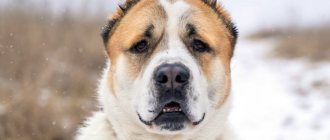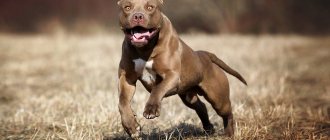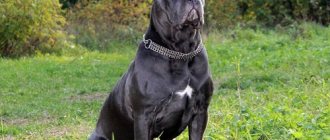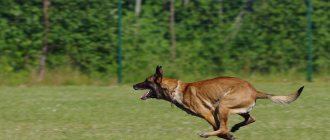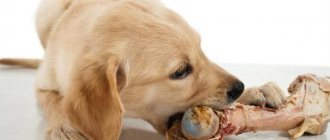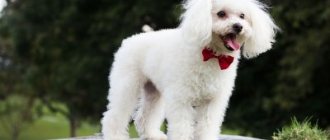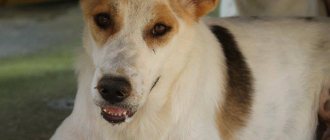Among the many animals domesticated by humans over thousands of years, dogs occupy one of the first places. They have proven themselves not only as loyal friends, but also excellent helpers in various areas of human life. From simple hunters, guards and shepherds, they turned into professional workers.
Today it is difficult to imagine the hard and dangerous work of rescuers without the use of trained dogs, not to mention the protection of farms, hunting and special therapy. What are the professions of dogs, what is their job, what breeds are suitable for performing certain tasks?
Security guards, guard and service dogs
One of the very first dog professions was that of a security guard. Since ancient times, tamed four-legged friends have guarded people's homes, but even today a guard dog is still in demand.
Pets are specially trained to protect residential buildings, various property and work in public service. Dogs guard the state border and strategic facilities (airfields, weapons depots, penitentiary institutions).
The list of breeds of service and military dogs is headed by German shepherds. They have proven themselves well as guards: Caucasian Shepherds, Rottweilers, Dobermans, Moscow guards and other breeds, endowed by nature with devotion, confidence and the ability to selflessly do their job. Brave, resilient and capable of making independent decisions, dogs are involved in detaining dangerous criminals, they are able to stop uninvited guests, and keep them in place until a person arrives.
Classification by animal size
Different breeds can serve people; the ability to help and be useful to a person does not depend on height and physique. Each variety has its own special characteristics that help dogs do the work assigned to them by humans.
Large breeds
These “large-sized pets” with their appearance speak about their purpose - security, protection and transportation of heavy loads. Impressive height, strong bones, strength and serious character are all characteristic features of these dog breeds.
Large service dogs – 25 breeds:
- German Shepherd
- East European Shepherd
- Central asian shepherd dog
- Caucasian Shepherd Dog
- South Russian Shepherd
- Anatolian Shepherd
- Romanian Carpathian Shepherd
- Romanian Shepherd Mioritic
- Kangal Shepherd
- Komondor
- Kuvasz
- Pyrenean mountain dog
- Estrela Mountain Dog
- Black Russian Terrier
- Cane Corso
- Neapolitan Mastiff
- Bullmastiff
- Saint Bernard
- Newfoundland
- Doberman
- American Staffordshire Terrier
- Rottweiler
- Giant Schnauzer
- Siberian Husky
- Alaskan Malamute
Important: among large dogs there are service breeds of dogs that can perform several types of service at once: guarding, herding livestock, being guide dogs.
Medium breeds
Compact, medium-sized service breeds are in no way inferior to their large relatives in intelligence, devotion and performance characteristics. They are also selflessly ready to protect a person and his property, and can become faithful assistants and the right hand of those in need of help. Dogs of this group are often used in customs affairs; they make good shepherds, hunters, sappers and guides.
Medium-sized service dogs – 24 breeds:
- Australian Shepherd
- White Swiss Shepherd
- Belgian Shepherd
- Border Collie
- Dutch Shepherd
- Collie
- Moody
- Picardy Shepherd
- Polish Lowland Sheepdog
- Polish Podgalian Shepherd Dog
- Portuguese Shepherd
- Bullets
- Pumi
- Old English Bobtail Sheepdog
- Croatian Shepherd
- Airedale
- Welsh Terrier
- Labrador Retriever
- Golden retriever
- German boxer
- Miniature Schnauzer
- Akita inu
- Shar Pei
- Schnauzer
Small breeds
This group includes the smallest breeds of service dogs. But, as they say, small but bold! All representatives of this group have excellent performance characteristics and are distinguished by loyalty and devotion to people.
List of small service dog breeds – 15 breeds:
- Bull Terrier
- Australian heeler
- Welsh Corgi Cardigan
- Welsh Corgi Pembroke
- American Miniature Shepherd
- Jack Russell Terrier
- Irish Glen of Imal Terrier
- German Hunting Terrier (Jagd Terrier)
- Parson Russell Terrier
- Czech Terrier
- Kerry Blue Terrier
- Scottish Terrier
- Miniature Schnauzer
- Miniature Pinscher (miniature pinscher)
- Dachshund
Important: in many sources you can find information that the Miniature Schnauzer is the smallest working dog breed. In fact, Miniature Pinschers are smaller than Miniature Schnauzers. Therefore, both dogs share the status of the smallest working dog breeds.
Hunters
Medieval hunting on horseback with a huge number of dogs is a thing of the past. But even today's hunting is difficult to imagine without four-legged helpers. Many hunting breeds are designed for different types of work. What types of hunting dogs are there?
Hounds
They track prey, sometimes following a bloody trail they find a wounded animal and drive it out to hunters, be it a hare, a fox or a deer. Hound breeds include:
- Rhodesian Ridgeback;
- beagle;
- basset hound;
- Foxhound;
- Russian hound dog.
Greyhounds
Greyhound dogs are used for hunting hare and fox without guns. They are able to chase their prey and grab it while running. Representatives of the breed:
- greyhound;
- whippet;
- Italian Greyhound;
- Russian and Afghan hound;
- pharaoh hound;
- Irish wolfhound.
Cops
A breed involved in hunting game birds. Dogs lift birds from reeds and ponds for shooting, search for and bring wounded and killed birds to the hunter. Coping breeds:
- German shorthaired pointer and drathaar;
- Hungarian Vizsla;
- English, Irish and Scottish Setter;
- English Pointer.
Burrows
Dogs chasing game out of a hole:
- dachshund;
- Jagdterrier;
- fox terrier;
- Jack Russell Terrier.
Likes
A small universal dog that is used both for hunting small game and for baiting bears.
Riding
The use of dogs as draft power to transport various goods and people has been known for a long time. Today, as a rule, sled dogs are not used for their intended purpose, only as entertainment. It is noteworthy that the conquest and exploration of the two poles, North and South, took place exclusively with the help of sled dogs harnessed to special harnesses. Famous sled dog breeds are the Samoyed Laika, Alaskan Malamute and Husky.
Bloodhounds
The name of this profession speaks for itself. Bloodhound dogs have an excellent sense of smell and are able to find delicious truffle mushrooms in the forest, drugs and explosives, wherever they are hidden, and a missing person.
For such work, dogs with a calm and balanced character are used, capable of learning more than just the ability to pick up a scent. In this difficult task, dogs of the spaniel, golden retriever and labrador breed serve people. The German Shepherd is also distinguished by its good sense of smell and ability to search.
Sniffers
For decades, sniffer dogs have been used to detect cross-border contraband, dangerous substances, weapons, explosives and drugs. Sniffers also have their own categories. There are these types of sniffing dogs:
- Minorary;
- Ore prospecting;
- Gas investigators.
There are sniffer dogs, whose peculiarity is used to search for truffles, as well as mold in residential areas. Naturally, it cannot be done without dogs, which are able to sniff out a criminal following a scent. It is noteworthy that animals with the most delicate sense of smell are able to pick up a trail left four days ago and follow it for more than 80 km. Recognized sniffing breeds include:
- German Shepherd;
- Airedale;
- Giant Schnauzer;
- Rottweiler;
- Bloodhound.
Rescuers
Specially trained dogs come to the aid of people during natural disasters and catastrophes. Swiss scientists conducted an experiment during which they hid a hypothetical victim in an area of 10,000 square meters and at a depth of 2 m. It took a team of experienced rescuers in full equipment 4 hours to find the person; the rescue dog did it in 12 minutes. For such work, dogs of the St. Bernard, Newfoundland and Labrador breeds are most often used.
Work as therapists
There is a practice when cute dogs come into the ward of people who have suffered serious injuries due to an accident or catastrophe and the patients communicate with them. Dogs often live in nursing homes or children's homes. They may even be mongrel.
Children with autism are helped out of this condition by pets. Therapists work with a group of 3 dogs. They lie around the little patient and he feels that he is not alone, someone in this world needs him. The baby communicates with them, plays and, more and more often, comes into contact with adults.
Shepherds
Herding dogs appeared several thousand years ago. These were mainly large dogs that protected the herd from predators - wolves, bears and strangers. Most shepherds, mountain dogs, corgis and some other breeds cope well with the role of shepherds.
There are also cattle dogs that perform more complex tasks. The shepherd's four-legged assistant must know every animal in the herd, drive it to pasture and back, and ensure that the cattle do not stray from the general herd. There are only a few such breeds, the most famous of which are the Australian Heeler, Flanders and Bouvier des Ardennes.
In the service of science
Here, astronaut dogs probably deserve special attention and honor. We can assume that this profession arose in 1957, when Laika’s paw entered orbit. On July 28, 1960, Chaika and Lisichka flew on the Vostok ship, and from August 19, 1960 to March 25, 1961, they made 5 more launches with 8 passengers. Bee and Mushka died then, but Belka, Strelka, Zhemchuzhina, Chernushka, Zhulka and Zvezdochka survived after the space experiments.
In addition, there are other “scientific” dog professions:
- Laboratory dogs;
- Dogs that predict earthquakes;
- Foster mothers for babies of other animals in zoos.
Dogs of any of the named professions are heroes, and their contribution to human life is simply colossal.
Guides
Specially trained dogs help people with physical disabilities and special needs overcome the challenges that await them at every turn. Labradors, German Shepherds and Giant Schnauzers are used to care for the blind, visually impaired, deaf, and people in wheelchairs. There are dogs trained to predict epileptic seizures and the defining signs of cancer.
Top 10: Dogs with the Most Unusual Jobs
Dogs are man's best friends. Since people first began trying to befriend wolves by luring them with pieces of food, the evolution of man and dog has gone hand in hand. Today there is a wide range of dog breeds, specially bred to help people in different areas of activity. From herding to lapdogs, there are dogs for every job these days, and some of those jobs are weirder than you think.
In this article, you will learn about ten types of work that dogs do that you didn't even know about.
10. Dogs help children testify
photo: CBS News
Is there anything more comforting than dogs trusting enough to let you pet them? When they lay their head on your lap, you know you've made a new friend. Not only can they provide a warm feeling, but dogs are used to help the legal system function with their calming presence.
For children who must testify in court, the pressure placed on them by the situation can be a real challenge. A child can be very frightened when dozens of eyes are looking at him: judges, lawyers, jurors. This is where a canine companion can come in handy. Dogs are used to assist children during testimony.
A trained dog can help a child from reporting a crime to the police to appearing in court. When in a courtroom, the dog is usually hidden behind the podium, sitting next to the child witness. This allows her to have a calming effect on the child without distracting the jury, since people often pay more attention to the dog than to the person with it.
9. Monk Dog
photo: screenshot YouTube/ Inside Edition
Dogs and religion are a divine combination. From St. Roch, a saint who found solace in his dog, and St. Christopher, who was often depicted with the head of a dog, to St. Guinfort, a dog who was considered a saint, man's love for a dog was often close to worship.
On a more mundane level, monks and churches often kept dogs to guard their gates. One Bolivian monastery decided that one dog was such a good boy that he deserved his own uniform.
Brother Carmelo is a schnauzer. He was once photographed wearing a tiny version of a monk's robe taken from a child's doll, and the dog monk has since become a social media darling. Online fans have nicknamed him "Brother Mustache" for his distinctive facial hair.
Although the official Catholic belief is that animals cannot go to heaven because their souls are not eternal (their souls die with their bodies), some priests have left the Pearly Gates slightly open for our animal friends. Pope Paul VI told one boy whose dog had died that “one day we will meet our animals again in the eternity of Christ, because heaven is open to all God’s creatures.”
8. Truffle Hunters
photo: screenshot YouTube/ZAGAT
Truffles are one of the most valuable foods on the planet. Due to their symbiotic relationship with trees and complex life cycle, we cannot cultivate them. If we want to experience their rich taste in our dish, then we will have to go “hunting” for them, but not with our limited sense of smell.
Some animals have a much more sensitive sense of smell than we do. For example, pigs are well known for their ability to sniff out truffles from underground, but they also have a habit of eating what they find. Dogs eat these valuable mushrooms much less often. Some dogs are taught to associate the smell of truffles with pleasure just a few days after birth.
The Lagotto Romagnolo (or Italian Water Dog) dog breed in Italy is now used primarily for truffle hunting. It used to be a hunting dog, and remains one - only for hunting non-animals.
7. Ball carriers
photo: screenshot YouTube/ SNTV — Inside every story
Catching and returning balls is one of the most popular pastimes for our four-legged friends. Why do we use boys and girls for this task during tennis matches? They decided to answer this question at a Brazilian tennis tournament. Several dogs, picked up from the streets of Sao Paulo, were dressed as ball carriers and released onto the court.
However, the goal of the game was not to replace their human counterparts. Since these dogs were strays, it was hoped that viewers would want to adopt them when they saw them. In the first year of the unusual experiment, all four “ball boys” were adopted. Soon new stray dogs appeared in their place.
Stray dogs weren't always the most obedient helpers on the court. They very quickly mastered catching balls, but were sometimes very reluctant to return them to the tennis players. And they used these unusual ball carriers only during warm-ups, because how can you carefully watch the match if there are dogs on the court?
6. Art guardian
photo: screenshot YouTube/CBS Boston
When we think of dogs as guardians of valuables, we most often think of menacingly barking watchdogs that are about to break loose in an effort to scare away burglars. However, Riley defends fine art from more subtle dangers. Riley is a museum dog who serves at the Museum of Fine Art in Boston, detecting many pests that could threaten the safety of works of art.
Pests such as moths and rats can destroy works of art in even the best museum. Using her nose, Riley sniffs them out before they can cause chaos. Riley was introduced to the museum at an early age so that he could get used to his surroundings and learn not to damage works of art himself.
Riley has since become the museum's mascot and is even featured in his own book: The Adventures of Riley, the Museum Dog.
5. Cancer detector
photo: screenshot YouTube/BBC Earth
A dog's nose is incredibly sensitive. While humans have about 6 million receptors, dogs have up to 300 million. Dogs also use a large part of their brain to interpret the smells they detect. So it's no surprise that dogs can smell things we don't even think we can smell.
Some dogs are so sensitive to changes in scents that they can tell when their owner is sick just by smelling them. Other dogs can be trained to detect certain diseases in complete strangers. A dog named Daisy was taught to detect cancer in people. After sniffing more than 6,000 samples, she correctly identified 550 people with cancer - including her owner.
“One day Daisy started nuzzling and scratching my chest with her paw, which really alarmed me,” her owner said. “I was examined and I was diagnosed with breast cancer at an early stage. Fortunately, I was able to cut out the tumor and be cured, but if it weren’t for Daisy, the disease would have remained undetected for a long time, and the consequences could have been completely different.”
Daisy was awarded the Blue Cross Medal in 2014 for her work in the health sector.
4. The Cheetah's Emotional Companion
photo: screenshot YouTube/CBS News
Everyone knows that owning a dog has a beneficial effect on the health of the owner. In addition to the beneficial physical exercise that comes from playing and walking with dogs, we also get huge mental health benefits from spending time with them. The relaxing company of a dog reduces feelings of loneliness and depression—and not just in humans.
Cheetahs are designed for speed and running across the vast African plains, and small enclosures in zoos can cause anxiety and depression in these animals. Constantly on the lookout for larger predators, they may feel threatened by crowds of visitors staring at them. A dog can be an ideal companion and has a calming effect on a cheetah.
Despite the mythical animosity that is said to exist between cats and dogs, both animals seem to enjoy being in each other's company. Dogs provide a calming presence and a sense of companionship, while cheetahs make great playmates for dogs.
3. Anti-tank dog
photo: screenshot YouTube/LastSoldier1
Not all types of work entrusted to dogs receive positive responses on social networks. During war, people often use their animals as helpers. These animals can be used as beasts of burden, guards, or even as weapons. Anti-tank dogs served as tank destroyers during the Great Patriotic War. Unfortunately, they themselves died.
The plan was to use the dogs as a means of delivering bombs to the most vulnerable part of the tank - under the bottom. At first, they were accustomed to the fact that food could be found under a tank, and were taught to avoid shelling and climb under tanks without fear of moving military equipment, and in combat conditions, an explosive with a detonator was attached to the dogs, which had not been fed for several days before, and released towards the tank, having first removed the fuse.
The German tank machine guns were located too high to be able to hit the fast-moving “bomb”. Over time, they began to use flamethrowers mounted on some tanks to destroy tank destroyer dogs. In addition, some dogs sometimes tried to return, which created a danger for the location of Soviet troops. Ultimately, anti-tank dogs were no longer used by 1942. According to some sources, the heroically killed tank destroyer dogs accounted for about 300 destroyed enemy tanks.
Fortunately, this is the kind of dog work that good boys are no longer trained for these days.
2. Penguin Defenders
photo: screenshot YouTube/USA TODAY
Invasive animal species can completely wipe out endemic populations, and human attempts to stop the spread of such species can often backfire. However, in one case the results were amazing. Middle Island, off the southern coast of Australia, is home to a colony of the world's smallest penguins, but their existence is threatened by foxes.
Little penguins, or blue penguins, are the smallest species of living penguin, but they have no natural defenses against foxes. Thanks to natural changes on the coast, foxes are now able to reach the island during low tides. When scientists recounted the penguin population on the island after the foxes arrived, they found that hundreds of penguins had been killed. Over the course of two nights, the foxes killed 360 of these miniature birds.
Then local poultry farmer Swampy Marsh came up with an idea: the dogs he uses to protect his birds from eager foxes, he proposed to use to protect penguins. Over the 10 years of work as guard dogs, there has not been a single death among penguins due to foxes. Good boys cope.
1. Mayor Max
photo: screenshot YouTube/Valentina Poddighe
Even the most beloved politicians will always have their detractors. The hardest person to find, however, is the one who hates the mayor of Idyllwild, California, because he's a dog. Named Maximus Mighty-Dog Mueller II at birth, he became mayor when he was just 11 weeks old.
Mayor Max is not the first dog to be appointed mayor of Idyllwild. His predecessor, Max I, died while in office, and after a rapid search for a replacement, the current mayor was found. First Mayor Max won the position at a charity event, beating out a number of other pets. Since Idyllwild is not a city and does not have its own government, Max's position is rather honorary.
Now Max II spends his time spreading happiness among his constituents. He can often be seen wearing a tie during weekend tours, cruising around town in the back of a pickup truck barking at his fans. Despite an "attempted murder" where another dog tried to bite Max on the neck, it looks like his lifetime appointment will continue for some time yet.
Doctors
There is a whole direction in modern medical practice - canistherapy. Dogs of absolutely any breed, including outbred dogs, participate in treatment and rehabilitation programs for children and adults with various cardiovascular diseases, Down syndrome, those suffering from autism, nervous disorders and social behavior disorders, hyperactivity and many other diseases. The effectiveness of this technique has been repeatedly confirmed.
Saint Bernard
This is one of the largest dogs used for various services. The Saint Bernard lends itself well to training and education, so there is no need to use force and a harsh approach. Such a dog needs to be treated with respect and does not tolerate harshness and injustice. During training, you need to take into account that a phlegmatic dog thinks in advance about how best to complete the task, and there is no need to rush him. It is better to train a puppy in a playful way, so you don’t have to yell at him and force him to do something, otherwise you can ruin your relationship with him.
Military
When there is a war, purebred and mongrel dogs help pull the wounded from the battlefield. They are looking for mines, they may bring mail. For all employees, communicating with a dog is a psychological relaxation.
Dogs are not only the most intelligent, but also hard-working animals.
If you can only laugh at the popular queries “how to make a cat work” (although there are also cat side jobs ), then doggies work not out of fear, but out of conscience.
For them there are both complex professions and simpler jobs. Here are the most popular vacancies. Photo: tailytales.ru
DISINSECTORS
Basically, small terriers that are bred specifically for this purpose are hired for this type of work. They help fight insects - garden pests.
This canine specialty is most common in America.
ACTORS AND CIRCUS PERSONS
There are dogs that work regularly in the circus, and there are also those that live freely. And, by the way, they earn not only a pittance and bring profit to the owner. When they start their own blog or account on Instagram and the likes go off scale, the owner also receives excellent advertising.
Photo: Efrem Lukatsky
THERAPISTS
These four-legged employees perform very noble work. They give their love and affection to those who need it most. These include people who have experienced an accident or the loss of a loved one, autistic children, and the disabled.
Therapy dogs sometimes help better than any medicine. Both a purebred dog and an ordinary mongrel can heal a person. Dogs also provide excellent support for retirees in nursing homes.
Photo: gaoordi.ru
MILITARY
One of the most difficult and dangerous professions. Dogs at war side by side with humans. They pull the wounded from the battlefield, search for mines, and sometimes even sacrifice their lives. In addition to helping in battles, they bring letters and help soldiers with psychological relief.
SHEPHERDS
One of the oldest professions, which a dog can do even better than a human. There are many breeds specially bred for this purpose. The dogs do not allow the herd to scatter, driving the animals into a circle. And if someone breaks away from the group, they will definitely find the fugitive and bring him back.
GUIDES
Guides are indispensable helpers for visually impaired people. They are always there, showing you the way, protecting you from troubles and simply supporting you. Dogs begin to be trained to be companions from puppyhood. They stop near pits, walk around puddles, wait for traffic lights and don’t run away. Most often, Labradors are hired for such important work.
TALISMANS
A simpler, but very solemn work. Almost every American college and university has its own symbol dog. Her portrait is printed on all covers, T-shirts, and sometimes even on flags. Most often the symbol is English bulldogs.
Photo: zabort.ru
COURIERS
In many countries, dogs help owners or clients with deliveries. Some dogs go shopping and carry bags, and some dogs even work in the office and pass documents from one employee to another.
If you train your pet in time, he will happily offer his help to the courier. This is both convenient and makes you proud of your smart assistant.
Photo: forum.auto
RESCUE
Irreplaceable workers. How many cases have there been when dogs saved people in places where no one else could go! Rescue dogs are very brave and sensitive.
Once, scientists from Switzerland even conducted an experiment. They hid the man 2 meters deep and asked them to find him. The people completed the task in 4 hours, and the dog in 12 minutes. A similar profession is sniffer dogs.
TRUFFLE TASTERS
This vacancy is given to a Lagotto Romagnolo dog. Despite the fact that it is very ancient, it was officially recognized only in 1995. Such dogs have a particularly sensitive sense of smell and are able to search for expensive truffle mushrooms, which are considered a delicacy.
CARRIERS
Laikas, huskies and Samoyeds are capable of transporting people and heavy loads over long distances. In the North they are indispensable helpers. Sometimes only with the help of dogs can you transport provisions to the right place.
And, of course, the security guards. Although this is more likely not even a profession, but a calling. Tailed pets are always on the alert and worry that no one will offend us. After all, their main “specialty” is to love us people. And our job is to make dogs happy.
Since ancient times, dogs have been used in work: hunting, military affairs, messenger and guard service. People needed and still need four-legged helpers, which is why countless dog professions and directions have arisen.
Dogs walking in harness
Dogs of these breeds are very hardy. These include, among others: huskies, huskies, and Samoyeds. They can transport people and goods over different distances. Everyone remembers the story of the team leader Balto, who brought the vaccine and saved many people from death during the epidemic.
Archaeologists in Kamchatka, in the valley of geysers, found a harness that is at least 8 thousand years old. This means that already at that time people used dogs as sled dogs. In a day, dogs in sleds can cover a distance of 100 km. At the same time, they carry not only a person, people, but also cargo, a musher.
If you look at the appearance of sled dogs, you will see that they are medium in size, but stocky and fluffy. An excellent undercoat protects them in severe frosts. These dogs are able to make decisions independently and act in difficult situations.
They say that among some northern peoples who honor traditions, puppies eat from the same plate with children. This makes the connection between them even stronger. Sled dogs are loyal and friendly. There was a practice when a dog that showed aggression towards a person and bit him was immediately killed in the village.
Rottweiler
These purebred dogs are considered not the most flexible, but the majority of Rottweilers refutes this opinion. It all depends on the surrounding atmosphere and upbringing. These dogs are inferior to some of the next dogs in size, but not in courage and reaction speed. The enemy has almost no chance to escape from such a pursuer. Rottweilers have well-developed fighting characteristics, so they require early socialization and training. In training, you need to pay attention to discipline - the dog must follow commands the first time. When training, you cannot be nervous, scream, or be restless, otherwise the dog will feel weak. The owner must be strong-willed, consistent and fair.
Content
Any large dog, which is each representative of the service class, must be well-bred. Otherwise, there is a high probability that the owner will have to face various kinds of troubles. At the same time, an uncontrolled animal can cause harm to others. The owner of a service dog must be aware of the full responsibility. Such pets require training: first general, and then service. To obtain a breeding class, an animal needs a diploma of passing one or more training courses. A properly balanced feeding diet plays a vital role in the development of good health for a service dog. High-quality nutrition requires considerable expenditure.
Doberman
Unlike the robust Rottweiler, this dog has a slimmer build. Already during the selection of this breed, it was clear that its representatives would ideally perform the work of a policeman, bodyguard and rescuer. And from the dogs used in breeding, they took all the necessary characteristics - a compact, strong body, poise, courage, instant reaction and aggression. Since Dobermans are naturally aggressive, they require stricter parenting and training. You need to start socializing your dog from an early age. Despite this peculiarity, Dobermans make excellent companions, adequate and friendly, they are great with children.
4) Pest killer spiders
There is now a high demand for organic food grown without pesticides, so farmers have to find ways to get rid of pests more naturally. Tesco, a British supermarket chain, forced all the farmers who supply them to use hordes of spiders that could rid their crops of harmful insects.
Dubbed "Nature's Choice," the project turned out to be brilliant on paper, as natural predators are much less effective at controlling pests than the pesticides that farmers mostly use. Another problem is that millions of spiders are collected along with the crops and end up on the table. Agree, it’s not very pleasant to feast on, for example, grapes when some giant poisonous spider, like a black widow, is looking at you from the bunch. After one encounter like this, you won't want to eat fresh fruit for the rest of your life.
Labrador Retriever
Labradors have a reputation as a loving family dog, ideal for active people, especially teenage children. These are balanced, calm, intelligent and gifted dogs. They are affectionate and obedient, insightful and faithful.
In official work, the keen sense of smell of the Labrador Retriever is considered ideal for search work, especially for detecting explosives and narcotic substances. The retriever has a wide and slightly elongated muzzle, which makes it possible to take in a lot of air through the nose and make it easier to detect the desired smell.
To teach a dog a special job, it takes at least two years of hard work by a specialist dog handler.
The Labrador Retriever is muscular and proportionally built. The coat is short and thick, the undercoat is waterproof.
Life expectancy is 12-13 years. The height of a male is on average 56-57, and that of a female is 54-56 centimeters, weight, respectively, is 27-40 and 27-35 kilograms.
The Labrador Retriever has long been a city dog; it is not suitable for being kept on the street. Walking on a leash is not enough for the animal; it is necessary to provide physical activity, jogging in the park or in places designated for walking dogs.
Recommended for active families with teenage children. You can take your dog on trips. Labradors love to swim.
German boxer
The ancestors of this breed were used for hunting deer, wild boar, and, less often, bears. Therefore, the boxer’s character is exceptionally bold and courageous. The nervous system is balanced, the temperament is flexible and calm. He is attentive to all family members, sociable, loves to communicate with the owner for as long as possible.
In most cases, he gets along quite well with other pets, but has a cocky character - he chases small dogs and cats on the street. It is better to immediately try to agree with the dog on the limits, because the boxer has a cunning mind - he knows who he can ask for sweets, who will give up his seat on the sofa and openly takes advantage of a person’s kindness. Excellent for security service, as it has endurance and good intelligence.
We offer you to read a complete review of the German Boxer service dog breed.
